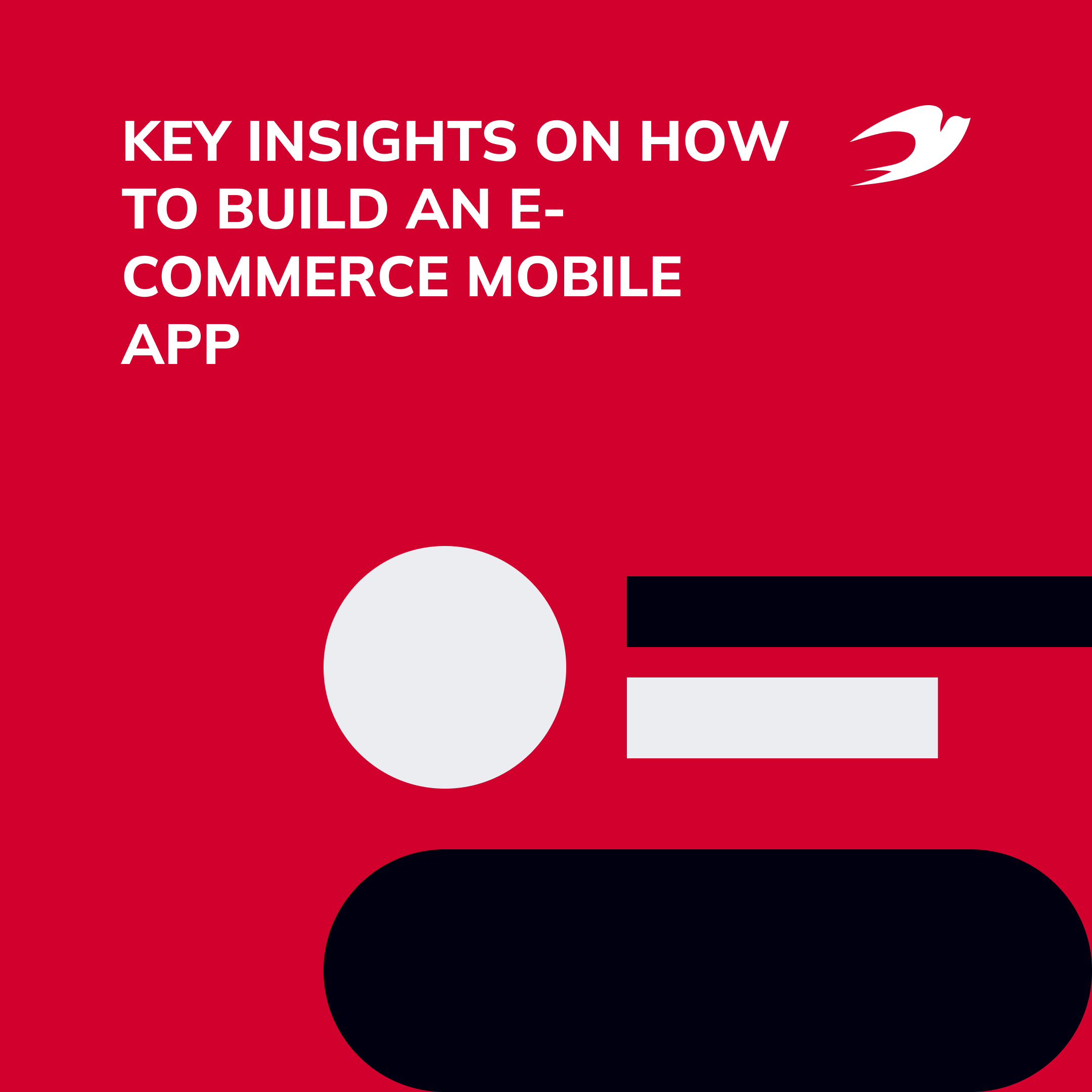E-commerce has long been one of the most promising areas of the retail industry. The ability to purchase online everything from groceries to electronics has opened up new perspectives for both buyers and sellers. Lockdown Covid-19 has shown that e-commerce is more than a trend, it is a necessity today, and mobile commerce is an even more convenient way of shopping for customers. So, it is no surprise that experts predict an increase in the number of shopping apps in the near future. But how to build a competitive e-commerce mobile app that will be interesting to users? Find your answers here. In this article, we’ve collected the key details for those who want to develop their own e-commerce applications, from selecting features to publishing and maintaining them.
Table of contents:
- The current state of the e-commerce market
- Must-have e-commerce app features: user panel
2.1 Easy registration process
2.2 Easy navigation
2.3 Multiple payment options
2.4 Shipping options
2.5 Order summary, status, and tracking options
2.6 Loyalty programs
2.7 Push notification
2.8 Feedback system - Must-have e-commerce app features: admin panel
3.1 Dashboard and analytics
3.2 Product/category management
3.3 Customer management
3.4 Promotions, rewards, points management - E-commerce trends in 2021:
4.1 Augmented Reality
4.2 Wishlist
4.3 Voice search - E-commerce app development process
- How much does it cost to build an e-commerce app?
The current state of the e-commerce market
E-commerce businesses thrived even before the 2020 coronavirus lockdown began. Covid-19 has reinforced this trend by making online stores a viable alternative to shopping malls. Lockdown times sparked an e-commerce boom, accelerating the move away from physical stores by about five years, according to the IBM Retail Index report. While sitting at home, people have fully appreciated the convenience of e-commerce apps that help us to get the best user experience. We don’t have to stand in lines and crowds in stores, instead, we can buy everything we need without leaving our homes.
Of course, new conditions have pushed retailers towards multi-channel order fulfillment to stay competitive in the market. Those stores that did not even think about an online presence a year ago are now forced to either quickly switch to digital or close. If you want to build a successful retail business, you will definitely need innovative e-commerce software solutions as the competition will only grow. According to Statista, in 2019, e-commerce retail sales worldwide reached $3.53 trillion, and e-commerce revenues are expected to grow to $6.54 trillion in 2022-2023.
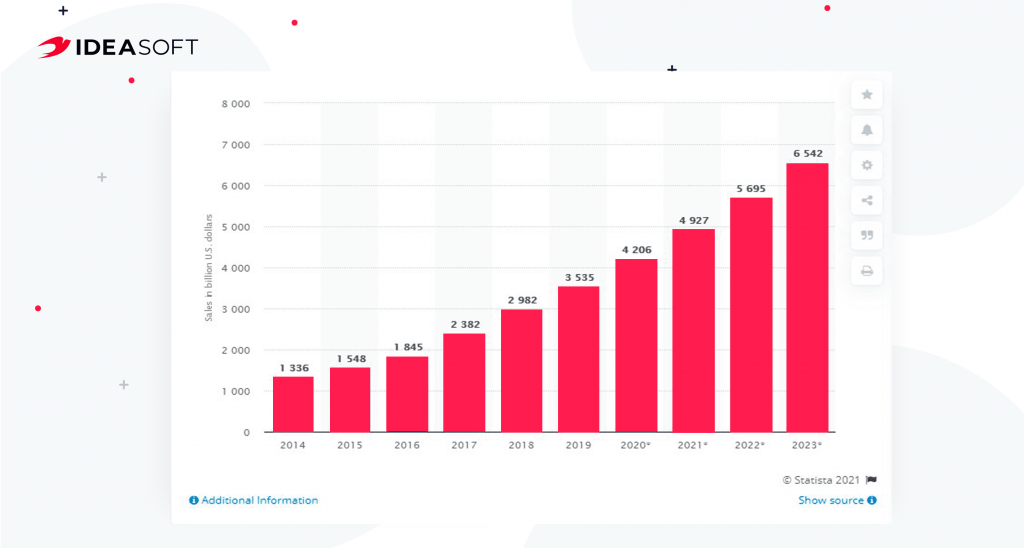
Read our recent article 11 Mobile App Development Trends to Watch in 2020/2021
Even more promising areas have appeared within e-commerce. One of them is m-commerce, which is expected to reach 44% of e-commerce in 2024, according to Business Insider Intelligence. Whereas earlier purchases with smartphones were possible due to mobile adaptation of websites, now more and more online stores are seeking to create separate mobile apps. According to numerous studies, shopping apps are more user-friendly, which increases the likelihood of making a purchase. Therefore, if you decide to create an e-commerce mobile app, you need to think about its features well and make sure that it meets the expectations of your users.
Must-have e-commerce app features
To create a user-friendly application that will benefit your business, you need to start with core features. This is the functionality that users expect to see by default when downloading an e-commerce app. It might seem obvious, but these features will form the basis of your product and will attract or repel users, so take your time to think about them. Your task is to ensure easy and convenient interaction with your app, from the very first minute. Plus, you shouldn’t forget about the admin panel. The application should be user-friendly for administrators who need to see up-to-date analytics, manage products, respond to orders, and much more.

User panel
Easy registration process
For users, the path of interacting with an e-commerce app begins with registration. They can start making purchases by creating their accounts. Try to keep the registration process as simple as possible. Don’t force a person to fill out dozens of fields at once. Start by creating a username and password, and users can enter billing, shipping, and other information later. An account is an important feature of any shopping app, as it stores order details, customer billing information, and more. Let your users customize their profiles and use the payment-checkout function to ensure a good user experience.
Easy navigation
The next step is easy navigation. Users need easily understand where they are (take care of visual clues), how to find a specific product, how to place an order, how to contact support and the like. In many ways, the convenience of navigation depends on a competent UX/UI design. Create clear menus, product categories, site search box, and filters to help users quickly find the products that best suit them. Complex and confusing navigation will scare away users. Don’t try to complicate things, the simpler the better. Therefore, place important actions at the top, design for touch screens, make texts easy to read, and it is better not to use horizontal scrolling.
Multiple payment options
Payment options are a critical feature for any e-commerce app. When setting up a payment gateway as part of your e-commerce solution, you should consider the flexibility of your payment options. It is best not to limit users to one option. Give users the ability to pay for goods using a credit card, PayPal, or even cryptocurrency. By having multiple payment gateways integrated into your app, you are more likely to meet the needs of your users and gain their loyalty.
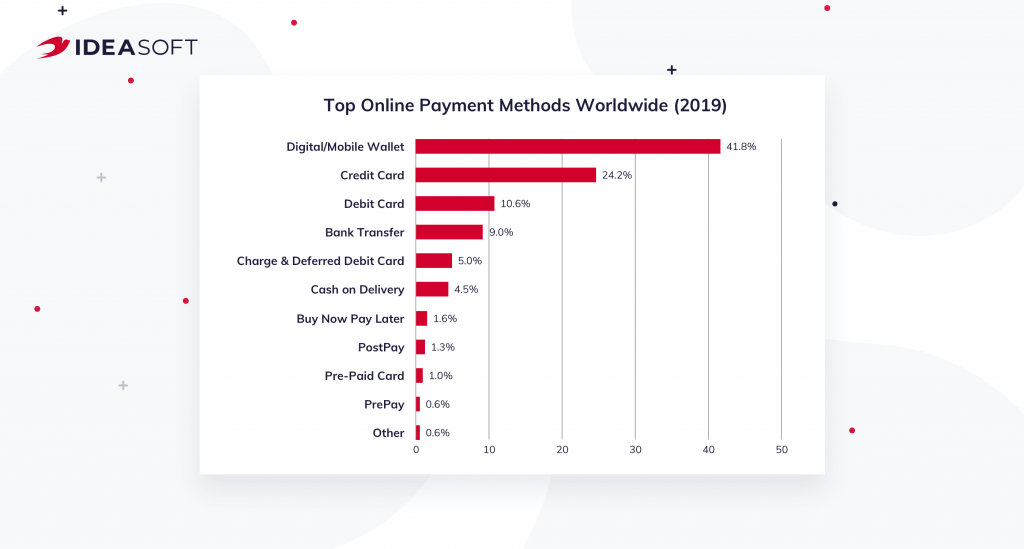
When it comes to online transactions, you should also pay special attention to security. Users must be sure that their payment information will not be available to third parties. Use a unique ID/OTP when confirming transactions and authorizing, activate two-factor authentication. Discuss with your development team all possible ways to ensure the reliability of data storage and transmission with your app.
Shipping options
Apart from payment options, we advise you to provide users with multiple shipping methods. This issue is inextricably linked to logistics and is an essential element of the foundation of e-commerce. User should be able to choose the methods of receiving the goods that you can provide right in the app, without wasting time on additional clarifications. Online shopping is different from physical store visits, so a seller’s job is to make the process of placing and receiving an order as comfortable as possible for customers to get repeat sales. A negative user experience will affect their attitude toward your brand.
Order summary, status, and tracking options
After placing an order, users want to know how it is progressing. To keep users informed, provide order summary and order status. Not every e-commerce app has tracking options, but this feature can be a great advantage for you. This way users will come back to the app to check the delivery status and so will interact with it more often.
Loyalty programs
Loyalty programs are one of the things that make mobile apps so popular. Reward programs for loyal customers increase user engagement and motivate them to buy more. You can say that this is a marketing tool, but it is better to think about it at the stage of application development to implement all the necessary features right in the app. This way you don’t have to develop additional solutions. Whatever it is, reward coins or discounts for next purchases, referral programs, special badges, you need to correctly implement this in the app to make the system work smoothly and become a real advantage.
Push notification
Push notifications can help you communicate effectively with your customers. With alerts notifications, you can inform customers about discounts, promotions, special offers, and much more. Push notifications, as well as loyalty programs, increase user engagement. However, you should remember that your job is to make them useful, not annoying. Give users the freedom to choose which notifications they want to receive by making this feature available on user accounts.
Feedback system
Feedback is as important for you as it is for users. User reviews give you an idea of what direction to move to get better, what problems users experience when interacting with your application. Provide customers with a simple feedback form, assessing the quality of the order, to understand how well the application works, how good the delivery is, how satisfied users are with your work, and whether they will recommend you.
Admin panel
Dashboard management and analytics
As for the business owner, it will be interesting for you to see information about the activity in your application. An e-commerce dashboard will allow you to take a snapshot of your business and dive into the most important data related to your online store, such as your revenue and sales figures, traffic. Detailed application analytics is the key to understanding how effective your product is. Make sure that at least basic analytical elements are implemented in your app. If you are planning to do analytics seriously, you may be interested in AI and ML-based solutions that allow you to quickly process data and identify patterns of user behavior.
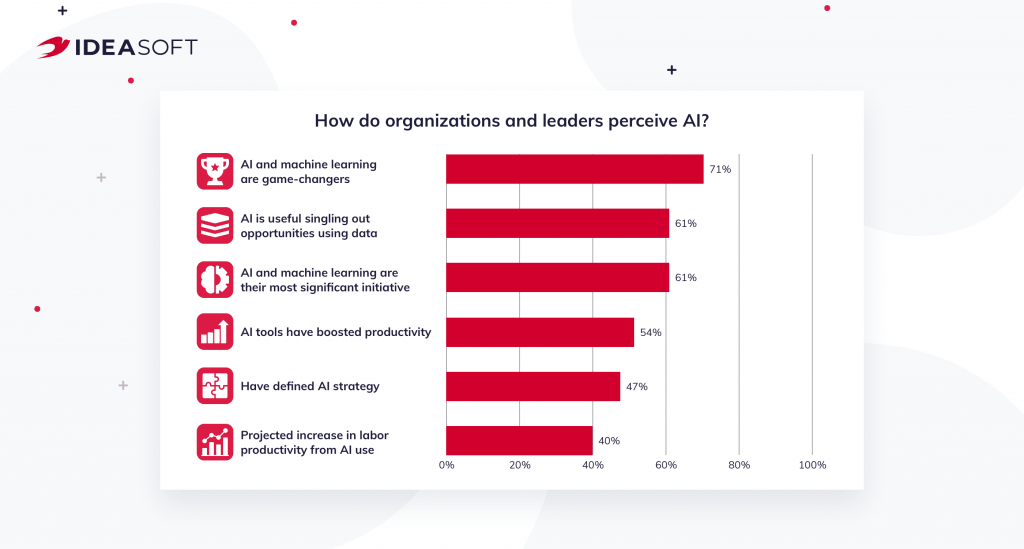
Product and category management
An online store should be convenient for both users and administrators. Admins will have to update information about products, manage categories, and add new articles. Take care of both design and implementation of these features. The admin panel interface should be intuitive and not confusing. Administrators should have easy access to the information they need. Think about access levels as well. Maybe some managers should have read-only rights, while others should have edit rights. Access levels will help reduce the likelihood of data breaches.
Customer management
With many users of your application, you will need a reliable client management tool. CRM system will allow you to store data about each user in a reliable and accessible form, which will simplify work with customer segmentation, processing complaints, preparing promotions, and special offers. Thanks to CRM, you will have a common database with detailed user cards, as well as a complete history of interaction with each user.
Interested in CRM development? Read our article How to build a custom CRM
Promotions, rewards, points management
Finally, administrators need a convenient tool for managing promotions and rewards. Whatever you decide to use a loyalty program or promotional codes, it shouldn’t take long for administrators to enable this feature for specific users or all of them. Discuss with your development team all possible options for implementing loyalty program management in an e-commerce app and choose the one that suits you.
E-commerce trends in 2021
Along with the basic features of a shopping app, you should also think about additional features that are optional but can generate customer loyalty. However, be careful here. Your task is to make shopping for your customers as comfortable as possible. If you introduce too many features into your app it can confuse users and prevent them from placing an order. Based on your target audience research, try to find out what can facilitate the interaction with the app for the end-user. Here are some ideas that have been trending in recent years.
Augmented Reality
Smart technologies are undoubtedly the number 1 trend for all industries in 2021. When it comes to augmented reality, using this technology in e-commerce applications can be a big advantage. The AR technology market is growing, according to Statista, and is projected to be worth more than $18 billion in 2023. Filters, preview placement when you can see in real-time what the product will look like when placed in the environment, try-on solutions, etc. All this not only contributes to the interest of users but also helps them make the right choice regarding the purchase. The main reason consumers returned items from Amazon and other retailers was the wrong size, fit, or color, Narvar reported. You can avoid these problems if consumers can try items on even when shopping online. A satisfied customer is a regular customer. This is why you shouldn’t ignore this trend when building your app.

Wishlist
Wishlist is not new, but still a powerful tool for learning user preferences and personalizing offers. By giving users the ability to collect the desired goods in their account, you solve several problems at once. Firstly, your customers will not lose products that they are interested in, and will be able to buy them when they have a chance. Secondly, knowing exactly what products users want, you can fulfill sales from customers who showed intent but didn’t end up purchasing. Using smart technologies, your app will also be able to automatically recommend the most suitable products to users based on the ones they have added to the wishlist.
Voice search
Google Assistant or Amazon Alexa are great examples of how voice assistants can improve user experience and become essential app features. Giving voice commands is much easier than typing the product name into the search bar. It is therefore not surprising that according to OC&C Strategy Consultants, voice commerce sales are predicted to reach $40 billion by 2022. Voice search gives users a unique experience. This saves time when browsing, entering billing and shipping information, and the device remembers past purchases, making it easy to reorder. By integrating voice search into your application, you can make purchases more comfortable for your customers.
E-commerce app development process
The process of creating an e-commerce mobile app consists of several stages, which include market analysis, drawing up a business plan, choosing technology, programming, testing, and further maintenance. You should start with the goals of your project, determine who your target audience is, what competitors are on the market, what features you want to see in your product. This stage should by no means be ignored, because according to statistics, one of the most common reasons for the failure of a software product is the lack of demand on the market. Only by understanding your potential users, you can create an app that will be interesting to them. If this task seems difficult for you or you do not have time to do this, you should trust the professionals and involve a business analyst in the process. This specialist will not only help you dive deeply into the study of your domain but will also be able to transform your wishes into understandable requirements for the development team.
Further, the process of building an e-commerce application goes as follows:
- Platform and technology selection
First of all, you should decide for which platforms you are creating the application. Do you want it to work only on iOS or Android, or are you interested in a cross-platform product? The choice of the platform will determine not only the tech stack of your project but also what kind of user experience you can provide to your users. If you decide that you want your app to run on all platforms, you still have to decide whether it is a native application or a hybrid one. Each type has its own advantages and disadvantages.
For example, a native application provides a great user experience because it is built with a specific platform in mind. However, you will have to develop 2 applications for Android and iOS separately, which will increase costs. A hybrid application is less expensive and takes less development time, however, it has poor performance and UX. That’s why we recommend developing a native app that can provide great performance and user experience for your e-commerce solution. Nexar is an example of such an app. Here’s a quick comparison of native and hybrid apps.
| Criterion | Native app | Hybrid app |
| Performance | Great | Worse |
| Development time | More time | Less time |
| Development cost | Higher | Lower |
| User experience | Great | Worse (mimics website) |
| Security | Can use device security features | Prone to attacks |
| Tech stack | Android: Java, KotliniOS: Objective-C, Swift | PhoneGap/Cordova or Ionic |
- UX/UI design
App design plays a crucial role in the success of a mobile app. The design of a mobile application should be developed taking into account user behavior patterns and device characteristics. The interface should be intuitive for users and motivate them to shop. Be sure to involve experienced designers in the process of creating the UX/UI of your application. A design flaw can be costly.
Here are some things to look out for when developing the UX/UI app design:
- Put key elements in the thumb zone, as studies claim that 75% of users use their thumb to interact with the device.
- App navigation must be touch-friendly, it should be convenient for users to get to different interface elements and perform actions.
- Users need no more than three steps to get to the desired product (three-tap rule), so keep your navigation easy.
- Keep design minimalistic so you won’t confuse users who need to cope with the interface elements on a small smartphone screen.
- Take care of the content. Photo and video product reviews will help customers in their choice.
- Programming
At this stage, a development team will bring your design to life with code. Make sure the developers have sufficient experience in mobile app development and understand how e-commerce works. You can significantly reduce development costs by outsourcing. In this case, a limitless market opens up in front of you, so you can choose a development team from any region that meets your requirements. Also, you do not have to devote all the time to development and technology, the provider company will take care of everything, and you can focus on other business tasks.
- Testing
Testing is the most important part of creating any software product. The more complex the system, the more likely it has some bugs. The main task is to fix them in time because users will not forgive you for problems with the application. According to Compuware, 48% of users are less likely to use an app again if they experience performance issues. Before launching the app, make sure it works as intended. We advise involving a tester at all stages of software product development, so as not to accumulate bugs. Here are some points to look out for when testing your e-commerce app.
- Make sure your app installs and works as intended.
- Make sure the app works the same on different devices and OS versions.
- Test the correctness of all typical operations (adding an item to the cart, placing an order, etc.).
- Check how the app behaves in case of special events (incoming call, low battery).
- Make sure your app meets app store requirements.
- Test the app with real users to make sure there are no problems with user experience.
- Decide who will be responsible for support and maintaining the application (dedicated team, outsourced services).
Conduct enough tests to ensure that your e-commerce app is working properly and will meet end-user expectations.
- Publication
After all tests have been completed, the app is ready to be published in app stores. We advise you to double-check the requirements of the stores through which you want to distribute your application, as some new requirements may appear. For example, in 2020 Apple introduced new rules for publishing applications in the App Store, according to which developers must indicate what personal user data an app collects. Sticking to the rules will speed up time to market for your product and you will sooner start getting new users.
- Tech support
During the first months after the launch of your application, you will begin to receive user feedback and will be able to plan further work on the product. You probably will want to add new features. In order to keep the app up to date, you need a technical support team. Of course, it is much better if the application is supported by the same company that developed it and knows everything about it. In any case, you need to decide who will be responsible for maintaining your app.
How much does it cost to build an e-commerce app?
As you see from all that was said above, it is quite difficult to create a single e-commerce application template. The more personalized and interesting your solution is, the more likely you are to find loyal users. In this regard, it is quite difficult to calculate the cost of developing an e-commerce application, because this is influenced by many factors, including the following:
- number and complexity of features
- selected application type
- development team size, which directly depends on the complexity of the project
- development time
- the seniority of software developers
- additional services (business analysis, design)
You should take into account that developer rates differ by region. Therefore, if the budget is a critical factor for you, choose the outsourcing option. This way you can find a development team that will offer you the best solution in terms of price and quality.
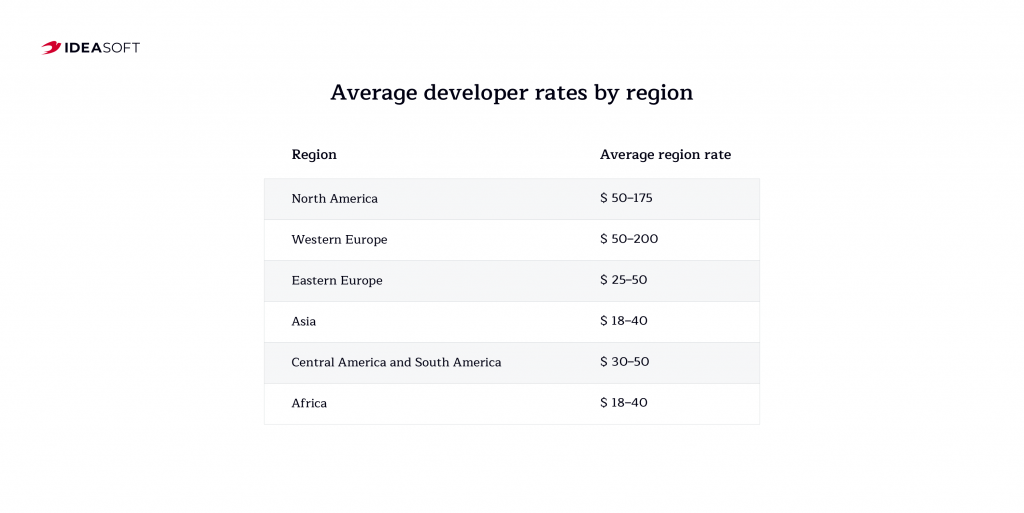
How we can help
IdeaSoft has been creating innovative software products for companies from various industries, including retail, for over 5 years. During this time, we have gained great internal expertise that allows us to help our Clients achieve their goals and get the best business outcomes. IdeaSoft offers full-cycle software development services, including business analysis, UX/UI design, programming, testing, and support. Therefore, if you are looking for a development team to build effective retail software solutions, we will be happy to provide you with our best specialists who will help you to unleash the full potential of your project. The experience of the IdeaSoft team is confirmed by over 250 successfully completed projects.
Let’s start communication right now. Contact us to get a free consultation and project cost estimate.

